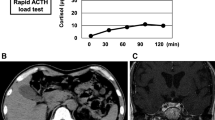Abstract
The diagnosis of adrenal insufficiency is discussed in case of low blood pressure and digestive symptoms. Rare inaugural abdomino-crural muscle contracture can be a misleading symptom. Here we report two new cases. A 50-year-old woman presenting a leaning forward walking attitude and negligence for the past 2 months was referred to the neurologic unit. Abdomino-crural contracture, clinical hypogonadism, and hyponatremia directed towards a panhypopituitarism, which was confirmed by subsequent investigations. Pituitary MRI found an empty sella turcica. The outcome was dramatic after hormone replacement therapy, with drawing up of the trunk and re-establishment of walking after a few days. The second case is a 58-year-old man, hospitalized with altered general condition, with a weight loss of 22 kg, and anorexia in the aftermath of a comminuted fracture of the right lower limb, complicated by pseudoarthrosis. There was amyotrophy on the extremities with intense cruralgia. The patient had an antalgic attitude in the flexion affecting his rehabilitation. During 1 year, the symptoms were mimicking psychiatric disorders, malabsorption, or cancer before the final diagnosis of central hypocorticism with normal MRI was established. The evolution was remarkable after a few days of therapy with hydrocortisone, where the myalgia disappeared, the patient quickly gained weight, and the disappearance of the retractions allowed rehabilitation. These two observations emphasize the delayed diagnosis of adrenal insufficiency in the case of abdomino-crural-related symptoms and the presence of misleading neurological symptoms. The mechanisms of this syndrome remain unknown.

Similar content being viewed by others
References
Odagaki T, Noguchi Y, Fukui T (2003) Flexion contractures of the legs as the initial manifestation of adrenocortical insufficiency. Intern Med 42:710–713
Wisenbaugh PE, Heller HM (1960) Flexion contractures in Addison’s disease. J Clin Endocrinol Metab 20:792–794
Aubertin E, Bergouignan M (1951) Muscular contraction syndrome during Addison’s disease; beneficial effect of cortisone. Ann Endocrinol 12:888–890
Steindler A (1955) Kinesiology of the human body under normal and pathological conditions. Charles C. Thomas, Springfield
Nishikawa T (2003) Flexion contractures possibly reflect the existence of hypocortisolism. Intern Med 42:629–631
Van der Sande JJ, Van Seters AP, Wintzen AR (1986) Dementia with contractures’ as presenting signs of secondary adrenocortical insufficiency. Clin Neurol Neurosurg 88:53–56
Addison T (1868) On the constitutional and local effects of disease on the suprarenal capsule. Collection of the Published writings of the late Thomas Addison MD. New Sydenham Society, London
Blandford RL, Samanta AK, Burden AC, Rosenthal FD (1985) Muscle contractures associated with glucocorticoid deficiency. Br Med J (Clin Res Ed) 291:127–128
Thorn DG, Dorrance SS, Day E (1942) Addison’s disease: evaluation of synthetic desoxycorticosterone acetate therapy m 158 patients. Ann Intern Med 16:1053–1059
Syriou V, Moisidis A, Tamouridis N, Alexandraki KI, Anapliotou M (2008) Isolated adrenocorticotropin deficiency and flexion contractures syndrome. Hormones 7:320–324
Ebinger G, Six R, Bruyland M, Somers G (1986) Flexion contractures: a forgotten symptom in Addison’s disease and hypopituitarism. Lancet 2:858
Mor F, Green P, Wysenbeek AJ (1987) Myopathy in Addison’s disease. Ann Rheum Dis 46:81–83
Pollen RH, Williams RH (1960) Hyperkalemic neuromyopathy in Addison’s disease. N Engl J Med 263:273–278
Jacobi JM, Killinger DW, Wolfe BM, Mahon JL, Rice CL (2001) Quadriceps muscle function and fatigue in women with Addison’s disease. Mus Nerv 24:1040–1049
George TM, Burke JM, Sobotka PA, Greenberg HS, Vinik AI (1984) Resolution of stiff-man syndrome with cortisol replacement in a patient with deficiencies of ACTH, growth hormone, and prolactin. N Engl J Med 310:1511–1513
Acknowledgments
We thank Docteur Massoud Heshmati for his help in the preparation of this manuscript and Pierre Mondor and Bertrand Degayffier for their expert assistance for the Web site movie.
Author information
Authors and Affiliations
Corresponding author
Rights and permissions
About this article
Cite this article
Harbuz, V., Bihan, H., Salama, J. et al. Flexion contractures possibly reflect the existence of hypocortisolism: two case reports. J Neurol 257, 1129–1133 (2010). https://doi.org/10.1007/s00415-010-5477-8
Received:
Revised:
Accepted:
Published:
Issue Date:
DOI: https://doi.org/10.1007/s00415-010-5477-8




